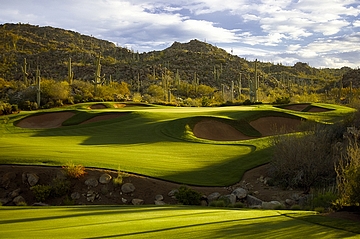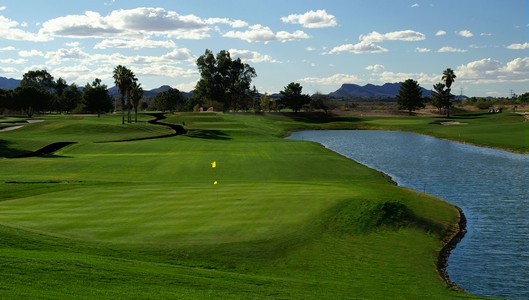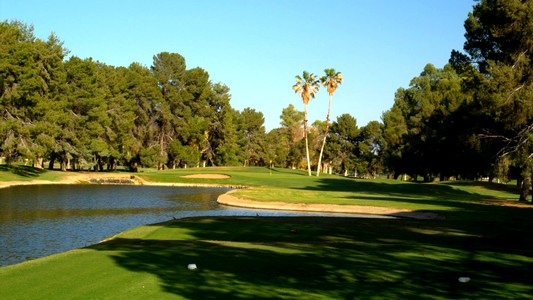Arizona Golf Authority AZGA Golf Course Buzz: If you would like to experience the true beauty of Arizona’s rugged desert landscape and play a little golf while you’re at it, Stone Canyon is just the place for you.

This private club, nestled against the Tortolita Mountains just north of Tucson in Oro Valley, is one of those layouts where you’ll wish you had a camera in your golf bag.
The panorama is dominated by a combination of spectacular mountain ranges, boulders as big as houses, virtual forests of towering saguaro cacti, flora and fauna with colors you didn’t think possible in a desert climate. You’ll be up close and personal with the native furry and feathered inhabitants as well, including mule deer, gila monsters, bobcats, roadrunners, javelina and desert quail. The whole property is a nature preserve that happens to be home to a golf course ranked the second-best in the state, #68 overall in the country and #2 for residential courses by Golf Digest magazine in 2010.
On the flip side, a struggling economy has made it difficult for this high-end, non-equity property to attract members in recent years, and the amenities package has taken a hit as a result. Stone Canyon opened in 2000 and although still doesn’t have a permanent clubhouse as of yet, its fitness facility is first-rate and the attendant indoor and outdoor dining is exquisite.
The course was designed by Jay Morrish, the famous understudy of Robert Trent Jones, George Fazio and Jack Nicklaus, who later teamed with Tom Weiskopf to create some of Arizona’s finest courses. Morrish said he was “overwhelmed by the site” and agreed to do the project “in about 14 seconds,” adding, “Nature designed the course. I was just the custodian.”
Stone Canyon offers five sets of tees, ranging from 7,353 to 5,133 yards, with a rating of 73.9 and a formidable slope of 145 from the tips. Just 78 acres of turf are in play, placing a premium on accuracy, while undulating greens, slopes, vast bunkers and thick rough put a golfer’s short game to the test.
Highlights of the round are two-hole stretches at Nos. 9-10 and 17-18. The ninth is a par-3 playing 227 yards from the elevated back tee; the tee ball falls some 75-feet to the green complex below. The 10th is a brutish par-5 of 622 yards, with another significant drop to the fairway, and plays to a smallish green with an approach over water. No, it’s not the longest hole on the course – that would be par-5 15th stretching 632 yards.
The finish at Stone Canyon is a pair of thrilling par-4s that vary in length by nearly 200 yards. No. 17 plays just 306 yards and is named Ambush Canyon because it swings down through a series of nefarious bunkers that will make you feel like you’re riding shotgun on a stagecoach with outlaws lurking behind every rock. The 18th, stretching 503 yards and a par-4 on the card, serves up the best mountain views on the course. If you can finish par, par here, your partners should carry you off the course on their shoulders.
Practice facilities are ranked among the best in the country, with about 12 acres of game-improvement area, and right behind it is a true 19th hole – a par 3 nicknamed “Double or Nothin” – that’s a lot of fun to play, even if there are no holdover bets to settle.
Read the Arizona Golf Course List AZGA Player’s Arizona Golf Course Review for every golf course in Arizona at www.arizonagolfauthority.com/coursedirectory.
It’s “All Things Arizona Golf” from the Arizona Golf Authority.




